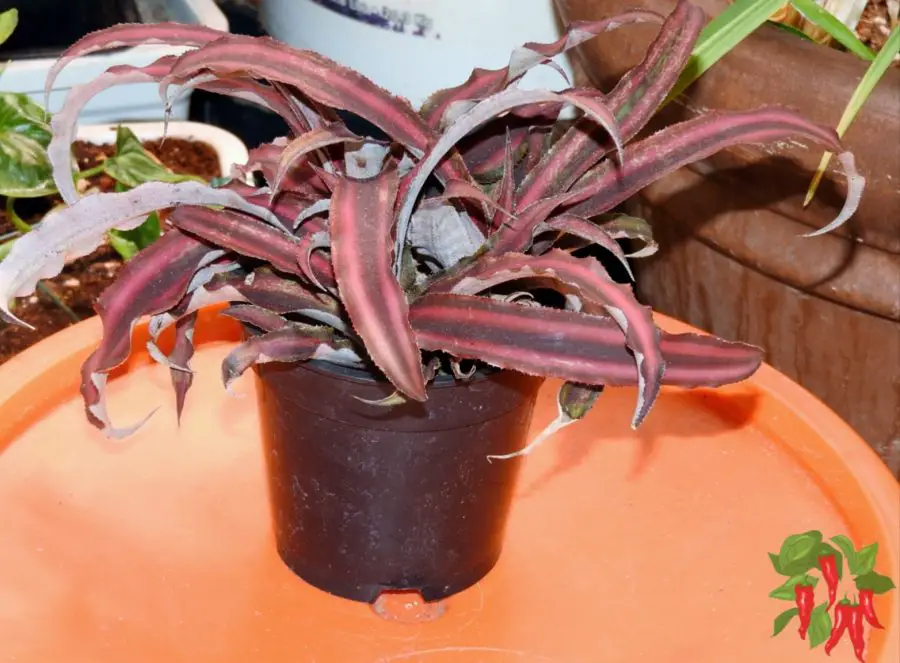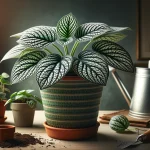This post may contain affiliate links. If you buy something from one of our links we may earn a commission. Thanks

Earth Star Plant Care made easy! Learn simple tips for watering, lighting, and keeping this stunning bromeliad healthy and happy indoors.
Earth Star Plant Care Key Takeaways:
- Earth Star Plant Care involves providing bright, indirect light, high humidity, and well-draining soil like coco coir.
- Water the soil, not the center, to avoid rot.
- Keep the plant in a warm room with consistent moisture.
- Watch for offsets or pups after it flowers to propagate new plants.
Earth Star Plant Care: Complete Guide to Growing Cryptanthus
Earth Star Plant Care doesn’t have to be complicated, but getting it right can make all the difference in keeping this vibrant bromeliad thriving.
If your plants are looking dull or struggling to grow, don’t worry—there’s an easy fix! Let’s dig into the simple steps to help your Earth Star look its absolute best.
Earth Star Plant Care Guide
| Characteristic | Details |
|---|---|
| Common Name | Red Earth Star, Earth Star, Red Earth Star Cryptanthus, Red Star Bromeliad, Starfish Plant |
| Botanical Name | Cryptanthus bivittatus |
| Native Habitat | Eastern Brazil, primarily in rainforests |
| Plant Type | Bromeliad, Terrestrial |
| Growth Pattern | Low-growing rosette form |
| Mature Size | 6-12 inches wide, 3-6 inches tall |
| Watering | Keep soil consistently moist but not waterlogged; mist regularly |
| Light/Sun Exposure | Bright indirect light; can tolerate low light |
| Soil Type | Well-draining potting mix; bromeliad mix or orchid mix |
| Soil pH | 5.5-6.5 (Slightly acidic) |
| Temperature | 60-85°F (15-29°C) |
| Humidity | High humidity (60% or higher) |
| Bloom Time & Flower Color | Small white insignificant flowers appear sporadically; grown primarily for colorful foliage. The plant dies after flowering but first produces pups |
| Potential Problems | Root rot, mealybugs, scale insects, leaf burn from direct sun |
| Repotting | Every 2-3 years or when pups can be divided |
| Hardiness Zones (USDA) | 10-11 (typically grown as houseplants) |
What Is the Earth Star Plant (Cryptanthus)?
The Earth Star plant, also known as Cryptanthus, is a tropical bromeliad that’s as eye-catching as it is unique.
With its vibrant red color and compact, star-shaped growth, it’s perfect for small spaces or terrariums.
Let’s explore what makes this easy-care plant a favorite among indoor gardeners.
- Cryptanthus is a terrestrial bromeliad, meaning it grows in soil rather than attaching to trees.
- Its star-shaped rosette gives it a striking appearance, earning it the nickname “Earth Star.”
- The leaves have a textured, slightly prickly edge but aren’t sharp or thorny.
- Native to Brazil, this plant thrives in humid, warm environments, mimicking its tropical origins.
- It’s compact in size, typically spreading out to about 6–12 inches, making it great for small indoor spaces.

Cryptanthus Red Earth Star Live Indoor Plant in 4 in. Plastic Grower Pot
Why Choose Cryptanthus?
Looking for a houseplant that’s both stunning and low-maintenance? Cryptanthus checks all the boxes. Its bold colors and compact size make it perfect for small spaces, while its easy-care nature appeals to plant lovers of all experience levels. Let’s explore why this little gem deserves a spot in your indoor garden.
- Eye-Catching Color: Its vibrant red and unique leaf patterns add a tropical vibe to any room.
- Perfect for Small Spaces: Compact growth makes it ideal for apartments, terrariums, or desktops.
- Low-Maintenance: Thrives with minimal care, making it great for beginners or busy plant owners.
- Versatile Displays: Works well as a centerpiece, in groupings with other plants, or as part of a terrarium arrangement.
- Functional Benefits: Adds a pop of color while purifying the air and enhancing your space’s aesthetic.
Basic Care Overview
Caring for a Cryptanthus is straightforward, making it a great choice for beginners and seasoned plant lovers alike.
This tropical beauty thrives with the right balance of light, water, and humidity. With minimal effort, you can keep your Earth Star healthy and vibrant. Here’s a quick rundown of its care needs.
- Light: Prefers bright, indirect light; avoid direct afternoon sun to prevent scorching.
- Temperature: Keep it in a room between 65°F and 80°F, as it thrives in warm, consistent conditions.
- Humidity: Loves humidity, so it’s perfect for bathrooms or terrariums; consider a pebble tray or humidifier if needed.
- Watering: Water the soil directly, keeping it moist but never soggy. Avoid watering the plant’s center to prevent rot.
- Soil: Use well-draining soil, such as coco coir or a mix with perlite, to keep roots healthy and prevent waterlogging.
Growth Patterns and Characteristics
The Earth Star plant has a unique growth habit that makes it a standout in any plant collection.
Its low-growing, star-shaped rosette and vibrant red leaves are eye-catching and compact.
Originating from Brazil’s tropical forests, this terrestrial plant is perfect for indoor gardeners looking for something bold yet manageable.
- Rosette Shape: The plant forms a flat, star-like rosette with textured, slightly prickly leaves.
- Compact Growth: It stays low to the ground, growing only a few inches tall but spreading up to 12 inches wide.
- Slow Grower: Cryptanthus grows steadily, making it ideal for small spaces without the need for frequent pruning.
- Terrestrial Nature: Unlike many bromeliads that grow on trees, this plant thrives in soil, mimicking its natural habitat on Brazil’s forest floors.
How and When to Water
Watering a Cryptanthus correctly is key to keeping it healthy and vibrant. This plant loves moisture, but overwatering or the wrong technique can cause issues.
By focusing on the soil and adjusting your routine for the seasons, you’ll ensure your Earth Star thrives without a hitch.
- Water the Soil, Not the Center: Always water the soil directly, as pouring water into the plant’s center can lead to rot and leaf problems.
- Keep Soil Moist but Not Soggy: Use a well-draining soil mix like coco coir to retain moisture without waterlogging. Let the top inch of soil dry slightly between waterings.
- Adjust for the Seasons: During active growth in spring and summer, water more frequently. In winter, reduce watering as the plant’s growth slows.
- Check Your Environment: If you’re in a dry climate or using heaters, you might need to water more often to maintain proper moisture.
Light and Temperature Needs
Providing the right light and temperature is essential for keeping your Cryptanthus happy and healthy.
This tropical plant thrives in bright, indirect light and warm, humid conditions. Choosing the right location in your home can make all the difference in its growth and vibrant color.
- Bright, Indirect Light: Place it where it gets plenty of light without direct afternoon sun, which can scorch its leaves.
- Best Window Placements: East-facing windows are ideal, offering gentle morning sun and indirect light throughout the day.
- Temperature Range: Keep it in a room between 65°F and 80°F for optimal growth; avoid sudden drafts or temperature changes.
- Humidity is Key: This tropical plant loves humidity, so consider placing it in a bathroom or near a humidifier. You can also use a pebble tray to maintain moisture in the air.
Best Soil and Containers
The right soil and container can make all the difference for a healthy Cryptanthus.
This plant thrives in well-draining soil and benefits from pots that encourage good airflow and moisture control.
Choosing the right setup ensures your Earth Star grows beautifully with minimal effort.
- Well-Draining Soil: Coco coir is an excellent choice for its ability to retain moisture while allowing excess water to drain.
- Soil Amendments: Add perlite to enhance drainage, especially if you live in a humid area or tend to overwater.
- Fabric Pots: These pots promote airflow to the roots and prevent waterlogging, which is especially important for tropical plants.
- Self-Watering Containers: Ideal for maintaining consistent moisture without overwatering, making care even easier.
Feeding Schedule
Feeding your Cryptanthus helps keep it vibrant and healthy, but it’s all about timing and using the right fertilizer.
This low-maintenance plant doesn’t need much, but a little boost during the growing season can make a big difference.
Here’s how to keep your Earth Star properly nourished.
- Growing Season: Fertilize once a month during spring and summer when the plant is actively growing.
- Dormant Period: Skip feeding in fall and winter, as the plant’s growth naturally slows down.
- Suitable Fertilizers: Use a balanced, diluted liquid fertilizer (e.g., 10-10-10) made for bromeliads to avoid overfeeding.
- Application Tip: Always water the soil before applying fertilizer to prevent root burn and ensure even absorption.
Dealing with Growth Cycles and Flowering
The Earth Star plant has a unique lifecycle that includes flowering and producing offsets, or pups.
While its blooms mark the end of the mother plant’s life, they also signal the beginning of new growth.
Understanding this cycle ensures you can keep enjoying Cryptanthus in your indoor garden.
- Flowering Process: Cryptanthus produces small, white flowers nestled in its rosette. While the blooms aren’t showy, they indicate the plant’s maturity.
- After Blooming: Once the plant flowers, the mother plant will gradually die back. This is a natural part of its lifecycle and nothing to worry about.
- Offsets (Pups): Before dying, the plant produces offsets around its base. These pups can be separated and replanted to continue the plant’s lineage.
- Managing the Cycle: Let the mother plant stay in place until the pups are large enough to separate (about a third of the mother’s size). Remove the mother plant once it dies to make room for the new growth.
Pests and Common Issues
Cryptanthus is generally a hardy plant, but like any houseplant, it can face a few challenges. Knowing what to watch for and how to address potential issues will keep your Earth Star looking its best.
Here are some common problems and simple solutions.
- Typical Pests: Mealybugs and scale are the most common pests. These can be treated with insecticidal soap or neem oil. Regularly inspect the plant for any signs of infestation, like white cottony spots or sticky residue.
- Root Rot: Overwatering or poor drainage can lead to root rot. To prevent this, use well-draining soil and let the top layer dry slightly between waterings.
- Leaf Problems: Watering the center of the plant can cause rot or fungal issues. Always water the soil directly instead.
- Preventative Measures:
- Ensure proper airflow around the plant.
- Keep humidity levels high but avoid excessive moisture on leaves.
- Remove dead or damaged leaves promptly to reduce the risk of pests or disease.
Propagating Earth Star Plants
Propagating Cryptanthus is an easy and rewarding way to keep your collection growing.
Once the mother plant produces offsets or pups, you can separate and replant them.
Here’s a step-by-step guide to help you propagate your Earth Star and care for the new plants.
- When to Separate Pups: Wait until the pups are about one-third the size of the mother plant and have visible roots. This ensures they are strong enough to grow independently.
- Step-by-Step Guide:
- Gently remove the plant from its pot, being careful not to damage the pups or roots.
- Use a clean knife or scissors to cut the pup away from the mother plant, keeping as much of the pup’s roots intact as possible.
- Prepare a small pot with well-draining soil, such as coco coir mixed with perlite.
- Plant the pup, ensuring its roots are covered and the base of the rosette is just above the soil line.
- Water lightly and place in a spot with bright, indirect light.
- Care for Newly Propagated Plants:
- Keep the soil slightly moist but not soggy.
- Maintain high humidity to help the pup establish itself.
- Avoid direct sunlight until the plant shows signs of new growth.
Creative Ways to Display Cryptanthus
The Earth Star plant isn’t just easy to care for—it’s also a stunning decorative piece. With its vibrant red hues and compact size, Cryptanthus can add flair to any indoor space. Here are some creative ideas to showcase this beauty in your home.
-
Terrariums:
- Place Cryptanthus in a glass terrarium to create a mini tropical landscape.
- Pair it with moss, small ferns, or pebbles for a balanced, natural look.
- Its love for humidity makes it perfect for enclosed or semi-enclosed terrariums.
-
Group Plantings:
- Combine Cryptanthus with green foliage plants to make its red color pop.
- Use contrasting leaf shapes and textures for an eye-catching arrangement.
- Create a bromeliad-themed grouping for a bold tropical display.
-
Tabletop Centerpiece:
- Use a shallow decorative bowl or pot for a statement piece.
- Surround it with natural elements like driftwood or small stones for added flair.
- Its low-growing habit makes it ideal for dining tables or coffee tables.
-
Highlight Its Color:
- Pair it with neutral or dark-colored pots to let its red tones shine.
- Place it near green plants or colorful blooms for a dynamic visual contrast.
- Use lighting to enhance its natural vibrancy, such as positioning it near an east-facing window.
Earth Star Plant (Cryptanthus) FAQs
Q: How much light does an Earth Star need?
A: Cryptanthus thrives in bright, indirect light. An east-facing window is ideal as it provides gentle morning sunlight and indirect light for the rest of the day. Avoid harsh afternoon sunlight, which can scorch the leaves.
Q: How do I water Cryptanthus without causing leaf problems?
A: Always water the soil directly, not the center of the plant. Pouring water into the plant’s rosette can lead to rot or fungal issues. Keep the soil moist but not soggy, allowing the top layer to dry slightly between waterings.
Q: Can Earth Star plants survive in low light?
A: While Cryptanthus prefers bright, indirect light, it can tolerate lower light levels. However, its vibrant red color may fade, and growth might slow down. For best results, place it in a spot with adequate brightness.
Q: What type of soil is best for Cryptanthus?
A: Use well-draining soil, such as coco coir or a mix with perlite. This ensures the roots have access to moisture without becoming waterlogged.
Q: How do I know when to separate pups from the mother plant?
A: Wait until the pups are about one-third the size of the mother plant and have developed their own roots. This typically happens after the mother plant flowers and begins to decline.
Cryptanthus Red Earth Star Indoor Plant Conclusion
Growing Cryptanthus is a rewarding experience, combining vibrant beauty with easy care. From its striking red leaves to its compact size and fascinating growth cycle, the Earth Star plant is a true gem for any indoor garden. Whether you’re a seasoned gardener or just starting, this tropical bromeliad is a joy to grow and display.
Key Takeaways:
- Earth Star thrives in bright, indirect light and high humidity.
- Use well-draining soil and water the soil directly to prevent rot.
- Propagate easily by separating pups after flowering.
- Ideal for indoor gardeners seeking a vibrant, low-maintenance plant.
Give this red beauty a try in your home, and don’t forget to share your experience with us. We’d love to hear how your Earth Star brightens your space. Happy gardening!
Learn more: Indoor Apartment Gardening: 15 Point Comprehensive Guide
Visit my Amazon Influencer Page for videos and gardening products Grow Your Own Garden






